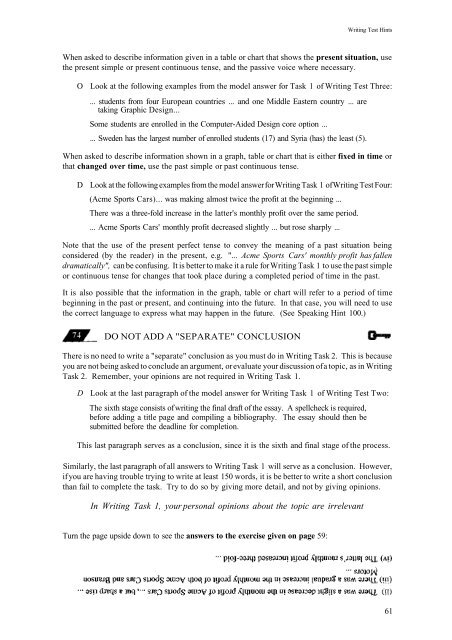Create successful ePaper yourself
Turn your PDF publications into a flip-book with our unique Google optimized e-Paper software.
Writing Test <strong>Hints</strong><br />
When asked to describe in<strong>for</strong>mation given in a table or chart that shows the present situation, use<br />
the present simple or present continuous tense, and the passive voice where necessary.<br />
O Look at the following examples from the model answer <strong>for</strong> Task 1 of Writing Test Three:<br />
... students from four European countries ... and one Middle Eastern country ... are<br />
taking Graphic Design...<br />
Some students are enrolled in the Computer-Aided Design core option ...<br />
... Sweden has the largest number of enrolled students (17) and Syria (has) the least (5).<br />
When asked to describe in<strong>for</strong>mation shown in a graph, table or chart that is either fixed in time or<br />
that changed over time, use the past simple or past continuous tense.<br />
D Look at the following examples from the model answer <strong>for</strong> Writing Task 1 of Writing Test Four:<br />
(Acme Sports Cars)... was making almost twice the profit at the beginning ...<br />
There was a three-fold increase in the latter's monthly profit over the same period.<br />
... Acme Sports Cars' monthly profit decreased slightly ... but rose sharply ...<br />
Note that the use of the present perfect tense to convey the meaning of a past situation being<br />
considered (by the reader) in the present, e.g. "... Acme Sports Cars' monthly profit has fallen<br />
dramatically", can be confusing. It is better to make it a rule <strong>for</strong> Writing Task 1 to use the past simple<br />
or continuous tense <strong>for</strong> changes that took place during a completed period of time in the past.<br />
It is also possible that the in<strong>for</strong>mation in the graph, table or chart will refer to a period of time<br />
beginning in the past or present, and continuing into the future. In that case, you will need to use<br />
the correct language to express what may happen in the future. (See Speaking Hint 100.)<br />
DO NOT ADD A "SEPARATE" CONCLUSION<br />
There is no need to write a "separate" conclusion as you must do in Writing Task 2. This is because<br />
you are not being asked to conclude an argument, or evaluate your discussion of a topic, as in Writing<br />
Task 2. Remember, your opinions are not required in Writing Task 1.<br />
D Look at the last paragraph of the model answer <strong>for</strong> Writing Task 1 of Writing Test Two:<br />
The sixth stage consists of writing the final draft of the essay. A spellcheck is required,<br />
be<strong>for</strong>e adding a title page and compiling a bibliography. The essay should then be<br />
submitted be<strong>for</strong>e the deadline <strong>for</strong> completion.<br />
This last paragraph serves as a conclusion, since it is the sixth and final stage of the process.<br />
Similarly, the last paragraph of all answers to Writing Task 1 will serve as a conclusion. However,<br />
if you are having trouble trying to write at least 150 words, it is be better to write a short conclusion<br />
than fail to complete the task. Try to do so by giving more detail, and not by giving opinions.<br />
In Writing Task 1, your personal opinions about the topic are irrelevant<br />
Turn the page upside down to see the answers to the exercise given on page 59:<br />
61




